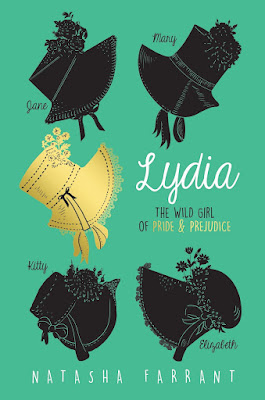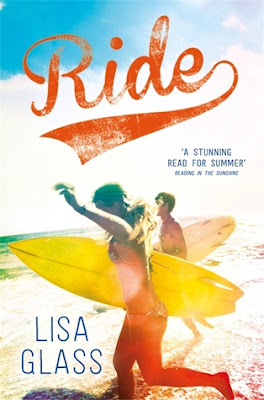Lydia - Natasha Farrant
As an Austen fan I was always intrigued by Lydia. She is portrayed in Pride and Prejudice as ditzy and irresponsible but what if she is just a misunderstood, ambitious young woman far ahead of her time? By giving Lydia a voice Natasha Farrant lets us see new corners of her mind and memory, allowing her to be reinvented as a feisty tomboy who dreams of equality and being able to do the same things as her male friends.
Lydia is a novel of two halves. The first is set at Longbourne, the Bennet family estate, and is basically Pride and Prejudice from Lydia’s point of view instead of Elizabeth’s. It is well-written and the moody weather makes for a powerful backdrop to the high-society melodrama here. However, for me, the book really begins when Lydia moves to Brighton. The seaside haven is written brilliantly and evocatively; the endless descriptions of the sea and cliffs are rich, colourful and sensual. Lydia comes into her own and grows up completely in just a few months. New characters are introduced, including a French Comtesse whose glamour and free-spiritedness dazzle Lydia.
Lydia’s story in Pride and Prejudice was always entwined with that of George Wickham, a military officer who she flirts with shamelessly and then runs away with. In Lydia their relationship is more complex and believable. She sees him as a friend first and foremost and feels like a man around him, which is what she ultimately wants. I won’t spoil the ending but the reason for their running off is very different to what it is assumed to be in Pride. It doesn’t paint Lydia in a much better light but it does make her behaviour more understandable.
One quibble I had was the constant references to fur clothes as objects of glamour. Yes, they were what people wore in those days but I think it becomes gratuitous after a while in the novel. It irked me that it was mentioned more than once in relation to the dressmaking work of the Comtesse Theo, a character who does not appear in Pride and Prejudice. As she is very forward-thinking for her time in many ways, having her not use fur in her work, or just not mentioning whether she does or not, would not have been too problematic.
The novel may have benefitted from being slightly longer – it ends quite dramatically after a certain key event and we don’t get to see the fall-out. Additionally, because it stops quite a way before the end of Pride and Prejudice, the stories of some of the secondary characters are not tied up. To someone who hasn’t read Pride, I can imagine this would be confusing and might seem as if the author forgot about some of the characters and plotlines.
On the whole, however, I found Lydia an enjoyable romp through nineteenth century society and I hope Natasha Farrant does more historical retellings. Her version of Lydia is a character that will stay with me for a long time.
*This review was originally written for Cuckoo Review (New Writing North) and is reprinted with permission*
Lydia is a novel of two halves. The first is set at Longbourne, the Bennet family estate, and is basically Pride and Prejudice from Lydia’s point of view instead of Elizabeth’s. It is well-written and the moody weather makes for a powerful backdrop to the high-society melodrama here. However, for me, the book really begins when Lydia moves to Brighton. The seaside haven is written brilliantly and evocatively; the endless descriptions of the sea and cliffs are rich, colourful and sensual. Lydia comes into her own and grows up completely in just a few months. New characters are introduced, including a French Comtesse whose glamour and free-spiritedness dazzle Lydia.
Lydia’s story in Pride and Prejudice was always entwined with that of George Wickham, a military officer who she flirts with shamelessly and then runs away with. In Lydia their relationship is more complex and believable. She sees him as a friend first and foremost and feels like a man around him, which is what she ultimately wants. I won’t spoil the ending but the reason for their running off is very different to what it is assumed to be in Pride. It doesn’t paint Lydia in a much better light but it does make her behaviour more understandable.
One quibble I had was the constant references to fur clothes as objects of glamour. Yes, they were what people wore in those days but I think it becomes gratuitous after a while in the novel. It irked me that it was mentioned more than once in relation to the dressmaking work of the Comtesse Theo, a character who does not appear in Pride and Prejudice. As she is very forward-thinking for her time in many ways, having her not use fur in her work, or just not mentioning whether she does or not, would not have been too problematic.
The novel may have benefitted from being slightly longer – it ends quite dramatically after a certain key event and we don’t get to see the fall-out. Additionally, because it stops quite a way before the end of Pride and Prejudice, the stories of some of the secondary characters are not tied up. To someone who hasn’t read Pride, I can imagine this would be confusing and might seem as if the author forgot about some of the characters and plotlines.
On the whole, however, I found Lydia an enjoyable romp through nineteenth century society and I hope Natasha Farrant does more historical retellings. Her version of Lydia is a character that will stay with me for a long time.
*This review was originally written for Cuckoo Review (New Writing North) and is reprinted with permission*




Comments
Post a Comment